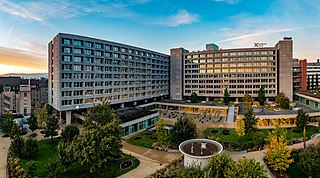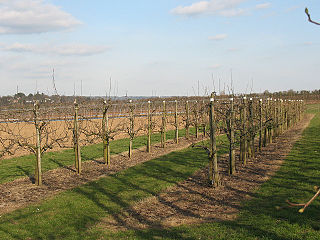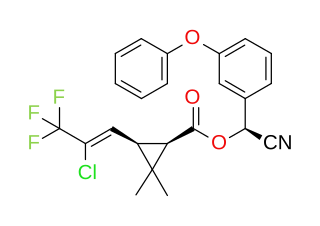
Imperial Chemical Industries (ICI) was a British chemical company. It was, for much of its history, the largest manufacturer in Britain. It was formed by the merger of four leading British chemical companies in 1926. Its headquarters were at Millbank in London. ICI was a constituent of the FT 30 and later the FTSE 100 indices.
Long Ashton Research Station (LARS) was an agricultural and horticultural government-funded research centre located in the village of Long Ashton near Bristol, UK. It was created in 1903 to study and improve the West Country cider industry and became part of the University of Bristol in 1912. Later, it expanded into fruit research and in the 1980s was redirected to work on arable crops and aspects of botany. It closed in 2003.

Paraquat (trivial name; ), or N,N′-dimethyl-4,4′-bipyridinium dichloride (systematic name), also known as methyl viologen, is an organic compound with the chemical formula [(C6H7N)2]Cl2. It is classified as a viologen, a family of redox-active heterocycles of similar structure. This salt is one of the most widely used herbicides. It is quick-acting and non-selective, killing green plant tissue on contact. It is also toxic (lethal) to human beings and animals due to its redox activity, which produces superoxide anions. It has been linked to the development of Parkinson's disease and is banned in 58 countries.

Fernhurst is a village and civil parish in the Chichester District of West Sussex, England, on the A286 Milford, Surrey, to Chichester road, 3 miles (4.8 km) south of Haslemere and 4 miles (6.4 km) north of Midhurst. The parish includes the settlements of Henley Common, Kingsley Green and Bell Vale, lies within the boundaries of the South Downs National Park and is surrounded by hills.

Syngenta is a global agricultural technology company headquartered in Basel, Switzerland. It primarily covers crop protection and seeds for farmers. Syngenta is part of the Syngenta Group, entirely owned by Sinochem, a Chinese state-owned enterprise.

Diquat is the ISO common name for an organic dication that, as a salt with counterions such as bromide or chloride is used as a contact herbicide that produces desiccation and defoliation. Diquat is no longer approved for use in the European Union, although its registration in many other countries including the USA is still valid.

NIAB EMR is a horticultural and agricultural research institute at East Malling, Kent in England, with a specialism in fruit and clonally propagated crop production. In 2016, the institute became part of the NIAB Group.

Azoxystrobin is a broad spectrum systemic fungicide widely used in agriculture to protect crops from fungal diseases. It was first marketed in 1996 using the brand name Amistar and by 1999 it had been registered in 48 countries on more than 50 crops. In the year 2000 it was announced that it had been granted UK Millennium product status.
The University of California Citrus Experiment Station is the founding unit of the University of California, Riverside campus in Riverside, California, United States. The station contributed greatly to the cultivation of the orange and the overall agriculture industry in California. Established February 14, 1907, the station celebrated its 100th anniversary in 2007.

Cyhalothrin is an organic compound that, in specific isomeric forms, is used as a pesticide. It is a pyrethroid, a class of synthetic insecticides that mimic the structure and properties of the naturally occurring insecticide pyrethrin which is present in the flowers of Chrysanthemum cinerariifolium. Pyrethroids such as cyhalothrin are often preferred as an active ingredient in agricultural insecticides because they are more cost-effective and longer acting than natural pyrethrins. λ-and γ-cyhalothrin are now used to control insects and spider mites in crops including cotton, cereals, potatoes and vegetables.
Jealott's Hill is a village in the county of Berkshire, England, within the civil parish of Warfield. The settlement is on the A3095 road approximately 3 miles (5 km) north of Bracknell. The nearest railway station is in Bracknell. The name of the hill is reported to have derived from the surname of a 14th-century landowner, Roger Jolyl. This name evolved into "Joyliff's Hill" and then, on Henry Walter's Map of Windsor Forest, 1823, became "Jealous Hill". This changed again to "Jealot's Hill" on John Snare's 1846 map and by the 1920s the modern spelling was established.

Julius Kühn-Institut – Bundesforschungsinstitut für Kulturpflanzen (JKI) is the German Federal Research Centre for Cultivated Plants. It is a federal research institute and a higher federal authority divided into 15 specialized institutes. Its objectives, mission and research scope were determined by section 11, paragraph 57 of the 1987 Federal Law on the Protection of Cultivated Plants as subsequently amended.
CropLife International is an international trade association of agrochemical companies founded in 2001. It was previously known as Global Crop Protection Federation and started out as International Group of National Associations of Manufacturers of Agrochemical Products in 1967. Its members include the world's largest agricultural biotechnology and agricultural pesticide businesses namely BASF, Bayer CropScience, Corteva, FMC Corp., Sumitomo Chemical and Syngenta. The international body combines several national-level or continent-wide organisations, each one having the same goals but differing according to local language and custom.
4-Hydroxyphenylpyruvate dioxygenase (HPPD) inhibitors are a class of herbicides that prevent growth in plants by blocking 4-Hydroxyphenylpyruvate dioxygenase, an enzyme in plants that breaks down the amino acid tyrosine into molecules that are then used by plants to create other molecules that plants need. This process of breakdown, or catabolism, and making new molecules from the results, or biosynthesis, is something all living things do. HPPD inhibitors were first brought to market in 1980, although their mechanism of action was not understood until the late 1990s. They were originally used primarily in Japan in rice production, but since the late 1990s have been used in Europe and North America for corn, soybeans, and cereals, and since the 2000s have become more important as weeds have become resistant to glyphosate and other herbicides. Genetically modified crops are under development that include resistance to HPPD inhibitors. There is a pharmaceutical drug on the market, nitisinone, that was originally under development as an herbicide as a member of this class and is used to treat an orphan disease, type I tyrosinemia.

Bupirimate is an active ingredient of plant protection products, which has an effect as a fungicide. It belongs to the chemical family of pyrimidine sulfamates. Bupirimate has translaminar mobility and systemic translocation in the xylem. It acts mainly by inhibiting sporulation and is used for control of powdery mildew of apples, pears, stone fruit, cucurbits, roses and other ornamentals, strawberries, gooseberries, currants, raspberries, hops, beets and other crops. Bupirimate is not an insecticide. It is of low mammalian toxicity and is non-toxic to bees. However, it is used in many products which also contain insecticides.
The chemical industry in the United Kingdom is one of the UK's main manufacturing industries. At one time, the UK's chemical industry was a world leader. The industry has also been environmentally damaging, and includes radioactive nuclear industries.
Plant Protection Ltd was a joint venture formed in June 1937 between ICI and Cooper, McDougall & Robertson in the United Kingdom. The share capital was £1900. The new company had offices at 61 Curzon Street, London, but the manufacturing plant and technical staff were based at Yalding in Kent. ICI contributed the research facilities at Jealott's Hill in Berkshire. Coopers provided the commercial expertise, and the joint venture lasted until 1958, when ICI bought out Cooper, McDougall & Robertson, and Plant Protection Ltd became the ICI Plant Protection Division, a wholly owned subsidiary of ICI.

Fomesafen is the ISO common name for an organic compound used as an herbicide. It acts by inhibiting the enzyme protoporphyrinogen oxidase (PPO) which is necessary for chlorophyll synthesis. Soybeans naturally have a high tolerance to fomesafen, via metabolic disposal by glutathione S-transferase. As a result, soy is the most common crop treated with fomesafen, followed by other beans and a few other crop types. It is not safe for maize/corn or other Poaceae.

Fluazifop is the common name used by the ISO for an organic compound that is used as a selective herbicide. The active ingredient is the 2R enantiomer at its chiral centre and this material is known as fluazifop-P when used in that form. More commonly, it is sold as its butyl ester, fluazifop-P butyl with the brand name Fusilade.

Chesterford Park Research Station was a former crop protection research centre in Essex, and is now a science park with biotechnology companies.















